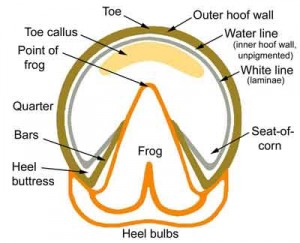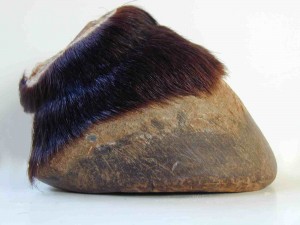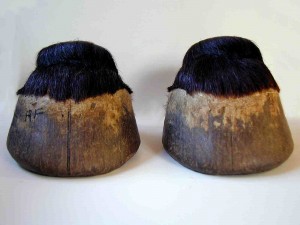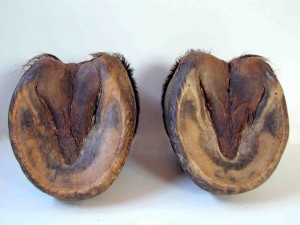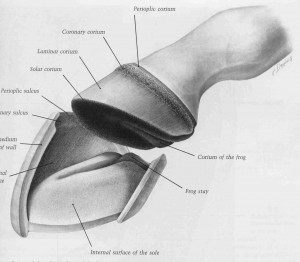Archive for the ‘Barefoot & Boots’ Category
The Four Pillars of Natural Hoof Care
Reference: Excerpts from an article by Narayan Khalsa from www.horseconscious.com
In our last article, we shared a few tenets on the importance of minerals in the horse’s diet to improve hoof health. What are some of the other factors we can look at to care for them even further? There are four basic pillars of hoof care. Lets look at them in detail:
Natural Boarding
In a natural boarding environment we emulate this need to move by creating what we call a paddock paradise. By setting up multiple feed stations in your paddock, using small mesh hay nets, propagating other interesting and healthful items like loose rock salt, we encourage our horses to move all day. This keeps your horse in shape, happy, entertained, and feet healthy. Adding rocks or pea gravel to parts of the paddock is great too. Being a herd animal, they need companionship. They value family like we humans do, and the need to have other horses in contact with them all the time is part of their nature in order to groom, play, even fight, but more than that – to love.
Natural Trim
By mimicking the natural wear patterns, only removing that which would be worn away in the wild, we help precipitate natural growth patterns, coaxing into form the truly natural hoof belonging to that unique creature. There is no set angle, no set toe length, and no set measurement of any kind. There is only undying variation in nature, and to try to manipulate a hoof into some set of measurements is dangerous. A NHC Professional does not need to worry about any of this, but simply apply the wear patterns and let nature take its course. Again a true Natural Trim is nothing more and nothing less than applying these wear patterns and only removing that which would be worn away in the wild.
Natural Diet
By eliminating high sugar commercial feeds, high sugar supplements, and high sugar grasses, you are eliminating one major cause of laminitis, the number two killer of domestic horses. Too much sugar saturates the hindgut, resulting in a bacterial imbalance that through a cascade of events starts to create a separation of the hoof from the horse. This is extremely painful for a horse and easily avoidable.
Natural Horsemanship
The horse has evolved to move in an exact fashion, through what we call the Natural Gait Complex. This is the walk, trot, canter, and gallop, in its myriad of forms. They did not evolve with a rider on their back, and so much consideration and preparation is needed. Most important, and the cornerstone of this pillar is riding in harmony with their natural gaits. By teaching a horse natural collection, the horse can develop a proper carrying shape, allowing them to carry a rider more comfortably without damaging them or causing them pain. We also recommend not mounting a horse until at least 5 years old, but if you will, closer to 7.
FINAL PROOF- Part 1
Thanks to EasyCareInc.com for posting this very interesting video on their Facebook page a few days ago…
This is extremely enlightening and once again opens up the debate of Traditional VS Natural (Barefoot) Hoofcare…
This video shows what could be considered one of the most important breakthroughs in modern hoof research. It proves the complete foundation for the traditional hoof care to be wrong. Since the coffin bone apparently is NOT hanging from the hoof wall the hoof wall should not be forced to carry the horse’s weight.
On the contrary- it would indicate that the hoof wall AS WELL AS frog and sole also need to bear the horse’s weight.
Therefore the practice of traditional hoof care and shoeing is forcing the horses to carry its ENTIRE weight peripherally (on the walls). This can cause significant damage as well of discomfort and even extreme pain.
[youtube]http://www.youtube.com/watch?v=ayEJacuoJ7I&feature=youtu.be[/youtube]
Book Review: My Natural Horses
As Natural Horsecare becomes more and more understood and more widely implemented it is important that we re-educate our children as well as adults in the new and yet age-old practice of natural horse care.
—————————————
My Natural Horses (by Anne Louise MacDonald) is a unique introduction to creating exceptionally healthy, happy horses.
This full-color photo-illustrated book is the first to show young readers the principles of Natural Horse Care, taking an entirely positive approach by following two horses, Isabelle and Prince, through all four seasons of the year.
Designed for ages seven and up, this book includes 150 exceptional photographs to delight everyone from the child who dreams of ponies to the active equine owner.
Larger text allows younger readers to get a basic understanding of Natural Horse Care, while smaller text gives more details to entertain and inform an older audience.
My Natural Horses is a joy just to look through, and an eye opener to an option in horse care that many horse people know little about.
Here is a Video Preview of Anne Louise’s book. Anne lives in Eastern Canada.
[youtube]http://www.youtube.com/watch?v=7VySnYyV-dk[/youtube]
My Natural Horses is available on AMAZON. Click here: My Natural Horses
New YouTube Channel!
[youtube]http://www.youtube.com/watch?v=MjOxS6kLG64[/youtube]Hello Everyone!
I just created a Passion for Horses YouTube channel and can now start loading all my edited horse videos so that I can share them with you.
Today I have my first video ‘My Life With Horses’ which is a kind of ‘trailer’ if you will, of my horses and a few of the horses I am blessed to work with everyday.
As I have time I will be creating all kinds of Natural Horsemanship videos about everything from riding, training, trails, trailering, horseplay, horsecare etc.
So as a starter, enjoy the video above! It is a somewhat humorous look at the non-stop action that these horses bring to my life.
Transition to Barefoot
How to Transition Your Horse to Being Barefoot…
Taking any particular horse from shoes to barefoot can take some time. A few horses will trot off barefoot on rocks and you will wonder why you ever put shoes on them. Many horses will be tender on rocks and hard ground at first.
The most important part of the transition to barefoot is getting an appropriate “barefoot trim” done on your horse. The typical “pasture” trim will not keep a barefoot horse sound.
Barefoot horses should NEVER have the toe callus trimmed (area of sole between the tip of the frog and the toe). Most farriers thin this area when placing shoes. Read the rest of this entry »
“HOOF WORDS” and “Wild horse” shape vs. typical long-heeled style
“Wild horse” shape vs. typical long-heeled style
Barefoot works best when the horse’s foot is trimmed to a fairly short-heeled shape. The drawings below of a short- and long-heeled shape (not accurate in details) show what happens to the coffin bone when the heels are long. Read the rest of this entry »
MUSTANG FEET
Mustang Feet
The Mustang is our best example of how healthy and hardy horses can be barefoot. Wild mustangs live on very hard ground, often extremely rocky ground. They also cover from 20-30 miles daily looking for food, water, and avoiding predators.
Mustangs have excellent hoof conformation with short heels, a dubbed toe, large frogs, and short bars. Mustangs are almost never seen with a hoof deformity or lameness.
However, our domestic horses ARE NOT mustangs. Not all horses live in arid rocky climates. A rider’s goals, their horse’s genetics and the boarding situation will make the difference in just how far an individual horse can go barefoot. A horse that is stalled the majority of the time may have problems living a barefoot lifestyle. Bare feet are natural, stalls are not.
Historically horses were ridden and used barefoot until a variety of husbandry changes occurred (stalling, diet, genetics) caused shoes to become necessary. Stabling conditions cause the feet to be exposed to extreme drying situations (bedding) which then became wet situations (soiled bedding) while minimizing hoof mechanism due to the restricted movement.
This leads to deterioration of the hoof wall and form, thus bringing about the practice of shoeing to keep them protected. The more turn out and exercise your horse gets the healthier their feet will be.
Horses that are primarily ridden in sandy arenas, or on soft trails may not need shoes. Horses that are ridden long distances on rocky or hard terrain will need more effort to ride barefoot, though it is often possible. Many disciplines will require shoeing for competitions or training as they are very different from what “wild horses do”.
For example, a reining horse will need shoes on the back feet in order to slide without abrading their back heels. Event horses who may jump large fences and make tight turns in mud often need shoes and removable studs for safety.
Barefeet have BETTER traction than shoes in most footing circumstances (rock, roads, firm ground). But when the mud is 6″ deep, there is no barefoot approach to over come it.
WHY BAREFOOT?
Hi Everyone!
Our theme for the next month or so is going to be dealing with Why we should keep our horses Barefoot as well as Why, How & When to Boot your horse.
We’ll start with…
WHY BAREFOOT?
Horses have 5 Hearts…one in the Chest…and one on EACH FOOT!
Each hoof has a huge blood supply. This blood supply is a dense collection of vessels much like a thick spider web or sponge.
In other species, the blood flows back up the limbs aided by muscle contractions that “squeeze” the blood back up the leg.
Horses do not have muscles in their lower limbs. Read the rest of this entry »


